In my last soap making post, I promised I’d share a recipe for making cold processed milk soap, using fresh goat’s milk. Some soapers shy away from using fresh milk, and advocate using dried milk, or diluting the milk with water, as fresh milk has a reputation for being difficult to work with.
However, if I used powdered milk, or diluted the milk, I think the goats would disown me, and honestly I don’t think it’s necessary.
If you have access to fresh goat’s milk, I think you should use it, whole, and unadulterated, as it makes a far superior milk soap.
There are a few things to consider when working with fresh milk in cold processed soaps though, as opposed to water, which I addressed in this post, including scorching of the milk during the heat of reaction with sodium hydroxide, and the difficulty, compared to water, of determining if the lye is completely dissolved before adding it to the carrier oils.
However, there are so many benefits to using fresh goat’s milk in the soap, including what it does for my hands, and that it prevents my freezer from overflowing with surplus milk, that I think it’s more than worth soaping with it.
Keeping the following in mind, I find that goat’s milk soap, once you get used to it, is no more difficult to make than any other cold processed soap.
- Always freeze the milk, it helps to moderate the heat of the lye reaction, and prevents scorching, and discoloring, the milk.
- Stir the milk and lye solution more than you think you need to, you can’t see the lye as easily in milk as you can in water, and undissolved lye will ruin your soap.
- While avoiding overheating the milk, don’t keep the lye and milk solution too cold either. If you do, this will happen.
- As with any cold processed soap, be prepared for the soap to move quickly if using any fragrance, or essential oils, as some may accelerate trace.
- Most importantly, keep notes!!! You’ll never learn what works for you, and what doesn’t, if you don’t keep good notes.
Below is my recipe for a 5% superfatted luxury Orange and Calendula goat’s milk soap. Note, however, that this is not your frugal pioneer-style bare bones soap. This is more of the I’m-going-to-spoil-myself-because-my-skin-deserves-it soap.
My hands are always either in dirt, or water, so the shea butter, cocoa butter, and almond butter, in addition to the fresh milk, all help to replenish the moisture I rob from my skin daily. It uses a 10x orange essential oil, which I find behaves very well in this soap, and doesn’t accelerate trace. The whole calendula petals added at trace add a little color and texture to this soap, but are optional, and can be omitted.
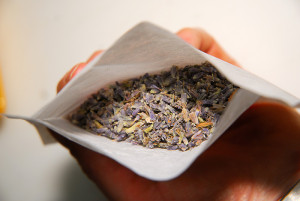
Dried herbs and flowers can be packed into a heat sealable tea bag, and used to infuse the carrier oils to add color or fragrance
Before I made this soap, I infused one of the carrier oils with calendula petals to extract some of their color.
Any of the liquid oils will work for the infusion, but I usually infuse olive oil, or rice bran oil. Two common ways making these oil infusions are to either allow the petals to steep at room temperature for one to two weeks, or simmer the oil and flower petals in a sealed glass canning jar, set in a water bath, over the lowest heat setting on the stove for 6-8 hours. Once the oil is infused, the calendula petals are discarded. Using a heat sealable tea bag makes this step much easier, as the bag is simply removed from the oil. The oil can then be stored in an airtight jar until ready to use.
Orange and Calendula Goat’s Milk Soap
Total Oil Wgt: 5 lb
Superfat: 5%
Carrier Oils:
Coconut Oil, 76 deg 454 g
Olive Oil 454 g
Rice Bran Oil 227 g
Avocado Oil 113 g
Castor Oil 113 g
Sweet Almond Oil 113 g
Shea Butter 113 g
Beeswax 23 g
Cocoa Butter 113 g
Palm Oil* 227 g
Palm Kernel Oil Flake* 272 g
Almond Butter 45 g
Lye Solution:
Goat’s Milk 640 g
Sodium Hydroxide 320 g
Fragrance:
10X Orange Essential Oil 99 g
Botanicals:
Dried Calendula Petals 100 g (optional)
(Print a PDF of this recipe, including conversions for pounds, and ounces.)
Prepare the Molds:
The first step is to prepare your molds. Once the soap is mixed, the molds must be ready to use. The choice of molds is entirely up to you.
Prepare the Oils:
Start by measuring out all of the carrier oils and butters, except the beeswax, and essential oil, into a large stainless steel soup pot, and set over low heat to dissolve the butters, stirring occasionally. Once melted, remove the oils from the stove, and allow them to cool to around 90 degrees.

The butters and oils can be melted together, but melt the beeswax separately to avoid overheating the oil
Beeswax has a very high melting temperature, and I find it best to melt it separately. You can either melt it in a small double boiler, or the microwave, stirring frequently. Once melted, add the beeswax to the warmed oils, and stir well.
Prepare the Lye Solution:
Just a reminder, whenever you’re making cold process soap, safety comes first. Clear the kitchen of pets, and children, and don your personal protective equipment before proceeding.
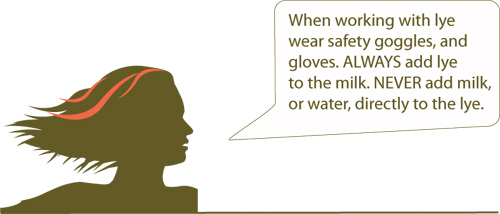
Chop up the frozen goat’s milk, and put it in a stainless steel bowl set over an ice bath.
Slowly, 1-2 Tbsp at a time, add the lye to the milk, and stir continuously with a silicone spatula or stainless steel spoon. Keep an eye on the temperature of the lye and milk solution, and avoid allowing the solution to heat up over 85 degrees. As soon as you add the last tablespoon of lye to the milk, remove the solution from the ice bath, and keep stirring.
I usually find the solution is between 65-70 degrees at this point. To ensure the lye dissolves completely, allow the mixture to come up to between 80-85 degrees. If the solution starts to get too warm, set the bowl back in the ice bath until you’re ready.
Mix the Soap:
Ideally you want the carrier oils and the lye solution to be within approximately 10 degrees of each other. If my lye solution is 80 degrees, I want my oils between 80-90 degrees. Too much difference in temperature can cause the soap to trace too quickly when it’s mixed.
Once both solutions are in the target temperature range, carefully pour the lye and milk mixture into the oil. I like to pour the lye solution down the lower half of my stick blender to avoid introducing too many air bubbles.
Stand the stick blender in the soap solution, and tilt it to the side to release any trapped air under the blades. Mix the soap solution to a light trace, and the oil and lye solution are thoroughly mixed. Add the essential oils, and calendula petals if using them, and switch to a spatula to stir the essential oil into solution. You can use the stick blender, but you’ll have more control, and avoid tracing the soap too far, using a spatula at this stage.
Immediately, and carefully, pour the soap into your prepared mold(s). I prefer to use tray molds, or silicone molds with goat’s milk soap.
Cover the soap with a little plastic wrap to prevent soda ash formation.
The last step is up to you. I prefer to keep my goat’s milk soap as light in color as possible. As such, I always freeze my soap for between 24-72 hours, depending on the depth of the mold. Loaf molds hold a larger mass of soap, and are left to freeze longer before unmolding. Shallow silicone molds can usually be unmolded in 24 hours. If allowed to gel at room temperature, wait at least 48 hours before unmolding.
Freezing the soap prevents it from overheating, scorching the milk, and turning the soap brown. Note, however, that some additives, including some fragrance oils like vanilla, or fresh honey, will still cause the soap to brown as it cures. Also, whenever you use dried flowers in cold processed soap (unless it’s a rebatched soap), the sodium hydroxide may cause the petals to discolor slightly during saponification. Calendula, compared to other dried botanicals, tends to hold its color better.
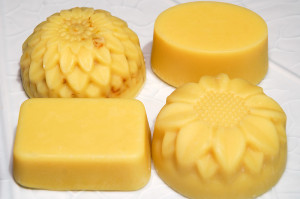
Orange and Calendula goat’s milk soap after 4 weeks curing. As the soap cures, the golden color intensifies.
I really like how this soap cures. It makes an all natural, firm bar, with a light scent, that’s long lasting, cleanses well, and has a creamy, and moderately bubbly lather. The calendula infused oil imparted just a little natural color, and freezing the soap prevented it from turning a dark brown. After a few weeks the soap finally cured to a beautifully rich golden color, and feels wonderful on the skin. Homemade milk soaps are yet another reason why I love having goats on the farm!
———————
SoapCalc – Any recipe, whether found in a book, or online, should be run through a lye calculator. This one is quite comprehensive, and will help you when substituting oils and butters, or scaling recipes.
Clean The World If you botch a batch of soap, and you don’t want to rebatch the soap yourself (I’ll post a recipe and method for rebatching goat’s milk soap soon), consider donating it. Clean the World can rebatch, and redistribute the soap to those in need.
* There is a lot of controversy about using palm oil in soap and cosmetic making. Even though palm oil is an excellent base oil for soap, and has some wonderful properties, its production, even ‘sustainably harvested’ palm oil production, can be detrimental to the environment, and to sensitive wildlife habitats. As such, once our existing supply of palm oil, and palm kernel oil flake, is exhausted, our soaps will be palm free.

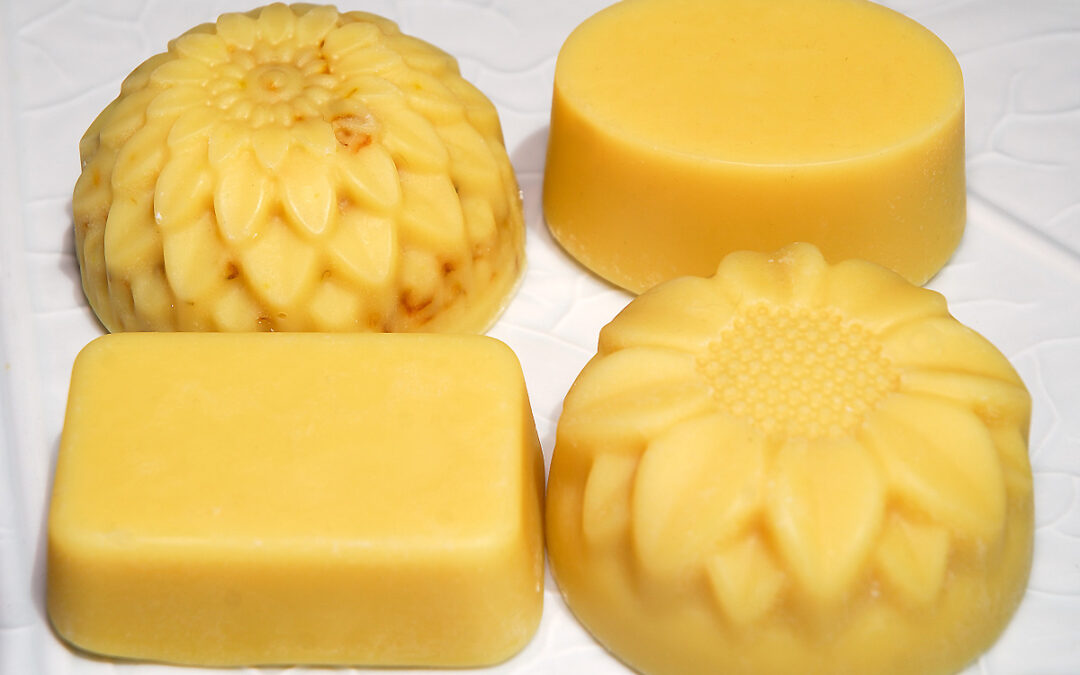

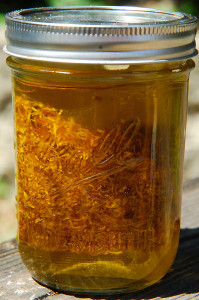


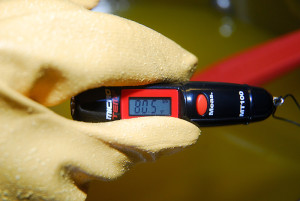
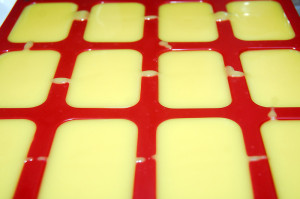
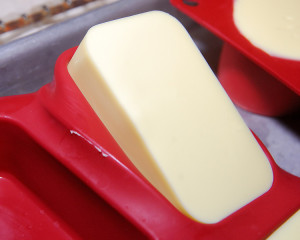
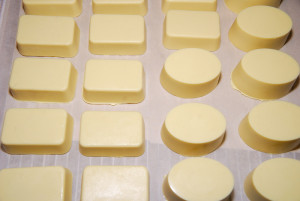







Clare this soap sounds yummy in fragrance and wonderful for your skin. If you ever sell your soap I want to know.
I am intending to sell some of these soaps, working on packaging now, and investigating potential online-vendoring options. I promise, I’ll let you know! 🙂